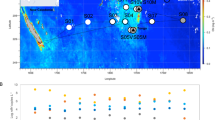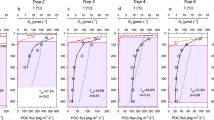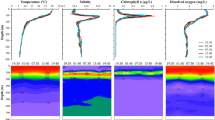Abstract
The oligotrophic gyres of the open sea are home to a flora that includes the largest known phytoplankton. These rare species migrate as solitary cells or aggregations (mats) between deep nutrient pools (below 80–100 m) and the surface. This migration contributes to new production because of the concomitant upward transport of nitrate1,2,3. But just how significant this contribution is remains uncertain because of the difficulty of making quantitative measurements of these rare cells4. Here we report remote video observations of a previously undersampled class of diatom (Rhizosolenia) mats throughout the upper 150 m of the central North Pacific Ocean. These mats are virtually invisible to divers, and their presence increases the calculated phytoplankton-mediated nitrate transport into the surface ocean by up to a factor of eight. Cruise averages indicate that Rhizosolenia mats transport 18–97 µmol N m−2 d−1; however, this value reached 171 μmol N m−2 d−1 at individual stations, a value equivalent to 59% of the export production5. Although considerable temporal and spatial variability occurs, this means of upward nutrient transport appears to be an important source of new nitrogen to the surface ocean, and may contribute to other regional elemental cycles as well6.
This is a preview of subscription content, access via your institution
Access options
Subscribe to this journal
Receive 51 print issues and online access
$199.00 per year
only $3.90 per issue
Buy this article
- Purchase on Springer Link
- Instant access to full article PDF
Prices may be subject to local taxes which are calculated during checkout


Similar content being viewed by others
References
Villareal, T. A. & Lipschultz, F. Internal nitrate concentrations in single cells of large phytoplankton from the Sargasso Sea. J. Phycol. 31, 689–696 (1995).
Villareal, T. A., Altabet, M. A. & Culver-Rymsza, K. Nitrogen transport by vertically migrating diatom mats in the North Pacific Ocean. Nature 363, 709–712 (1993).
Villareal, T. A., Woods, S., Moore, J. K. & Culver-Rymsza., K. Vertical migration of Rhizosolenia mats and their significance to NO−3 fluxes in the central North Pacific gyre. J. Plankt. Res. 18, 1103–1121 (1996).
Richardson, T. L., Cullen, J. J., Kelley, D. E. & Lewis, M. R. Potential contributions of vertically migrating Rhizosolenia to nutrient cycling and new production in the open ocean. J. Plankt. Res. 20, 219–241 (1998).
Karl, D. et al. The role of nitrogen fixation in biogeochemical cycling in the subtropical North Pacific Ocean. Nature 388, 533–538 (1997).
Brzezinski, M. A., Villareal, T. A. & Lipschultz, F. Silica production and the contribution of diatoms to new and primary production in the central North Pacific. Mar. Ecol. Prog. Ser. 167, 89–101 (1998).
Carpenter, E. J. et al. Rhizosolenia mats. Limnol. Oceanogr. 22, 739–741 (1977).
Villareal, T. A. & Carpenter, E. J. Nitrogen-fixation, suspension characteristics and chemical composition of Rhizosolenia mats in the central North Pacific Gyre. Biol. Oceanogr. 6, 327–345 (1989).
Banse, K. Clouds, deep chlorophyll maxima and the nutrient supply to the mixed layer of stratified water bodies. J. Plankt. Res. 9, 1031–1036 (1987).
Emerson, S. & Hayward, T. L. Chemical tracers of biological processes in shallow waters of North Pacific: preformed nitrate distribution. J. Mar. Res. 53, 499–513 (1995).
Parsons, T. R., Maita, Y. & Lalli, G. M. A Manual of Chemical and Biological Methods for Seawater Analysis (Pergamon, New York, (1984)).
Shipe, R. F., Brzezinski, M. A., Pilskaln, C. & Villareal, T. A. Silica production of Rhizosolenia mats in the central North Pacific gyre. (submitted).
Karl, D. M. HOT and the North Pacific Ocean. Nature 378, 21–22 (1995).
Karl, D. M. & Lukas, R. The Hawaii Ocean Time-series (HOT) program: Background, rationale and field implementation. Deep-Sea Res. 43 Part II, 129–156 (1996).
Karl, D. M., Hebel, D. V., Björkman, K. & Letelier, R. M. The role of dissolved organic matter release in the productivity of the oligotrophic North Pacific Ocean. Limnol. Oceanogr. 43, 1270–1286 (1998).
Eppley, R. W. & Peterson, B. J. Particulate organic matter flux and planktonic new production in the deep ocean. Nature 282, 677–680 (1979).
Goldman, J. C. in Toward a Theory on Biological-Physical Interactions in the World Ocean (ed. Rothschild, B. J.) 273–296 (Kluwer Academic, Dordrecht, (1988)).
Hayward, T. L. The shallow oxygen maximum layer and primary production. Deep-Sea Res. 41, 559–574 (1994).
Yoder, J. A., Ackleson, S. & Balch, W. M. Aline in the sea. Nature 371, 689–671 (1994).
McGillicuddy, D. J. J & Robinson, A. R. Eddy-induced nutrient supply and new production in the Sargasso Sea. Deep-Sea Res. 44, 1427–1450 (1997).
Hall, M. M., Niiler, P. P. & Schmitz, W. J. J Circulation in the eastern North Pacific: results from a current meter array along 152° W. Deep-Sea Res. 44, 1127–1146 (1997).
Davis, C. S., Gallager, S. M., Berman, M. S., Haury, L. R. & Strickler, J. R. The Video Plankton Recorder (VPR): Design and initial results. Ergeb. Limnol. 32, 67–81 (1992).
Alldredge, A. L. & Silver, M. W. Abundance and production rates of floating diatom mats (Rhizosolenia castracanei and Rhizosolenia imbricata var. shrubsolei) in the eastern Pacific Ocean. Mar. Biol. 66, 83–88 (1982).
Pilskaln, C. H., Lehmann, C., Paduan, J. B. & Silver, M. W. Spatial and temporal dynamics in marine aggregate abundance, sinking rate, and flux: Monterey Bay, central California. Deep-Sea Res.(in the press).
Martinez, L., Silver, M. W., King, J. M. & Alldredge, A. L. Nitrogen fixation by floating diatom mats: a source of new nitrogen to oligotrophic ocean waters. Science 221, 152–154 (1983).
Acknowledgements
We thank L. Joseph, A. Mansfield, C. L. De La Rocha, R. Shipe, W. Golden, S.Gallager, C. Lehmann and C. Darkangelo for providing diving and technical support. This work was supported by the NSF.
Author information
Authors and Affiliations
Corresponding author
Rights and permissions
About this article
Cite this article
Villareal, T., Pilskaln, C., Brzezinski, M. et al. Upward transport of oceanic nitrate by migrating diatom mats. Nature 397, 423–425 (1999). https://doi.org/10.1038/17103
Received:
Accepted:
Issue Date:
DOI: https://doi.org/10.1038/17103
This article is cited by
-
Impact of critical eddy diffusivity on seasonal bloom dynamics of Phytoplankton in a global set of aquatic environments
Scientific Reports (2023)
-
Fall and rise of the phytoplankton
Nature Climate Change (2022)
-
Vertically migrating phytoplankton fuel high oceanic primary production
Nature Climate Change (2022)
-
Nanomolar phosphate supply and its recycling drive net community production in the subtropical North Pacific
Nature Communications (2021)
-
Vertical migration by bulk phytoplankton sustains biodiversity and nutrient input to the surface ocean
Scientific Reports (2020)
Comments
By submitting a comment you agree to abide by our Terms and Community Guidelines. If you find something abusive or that does not comply with our terms or guidelines please flag it as inappropriate.



